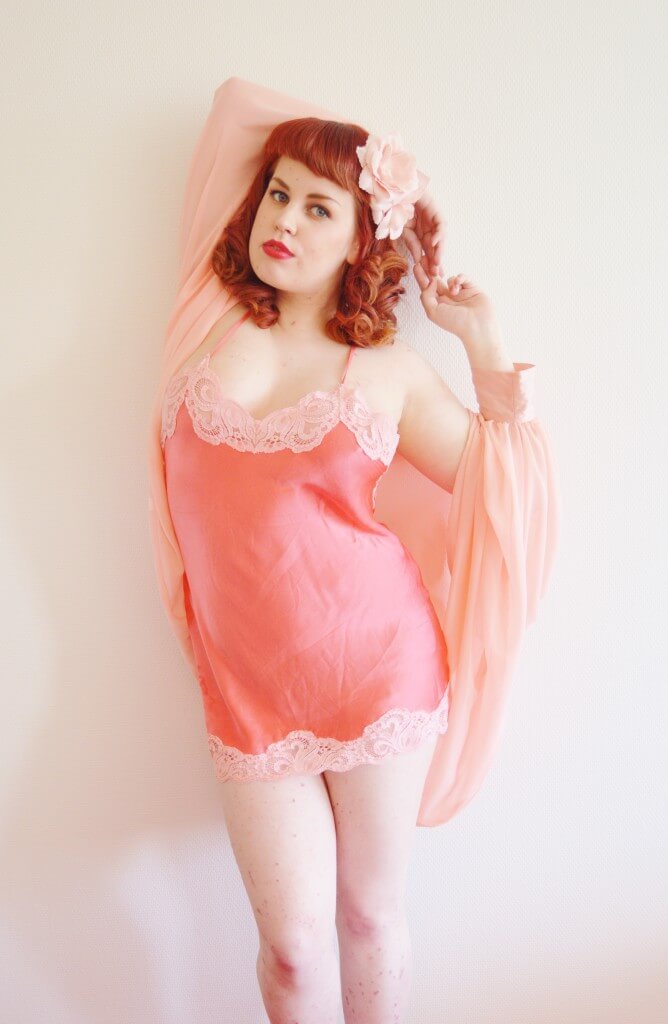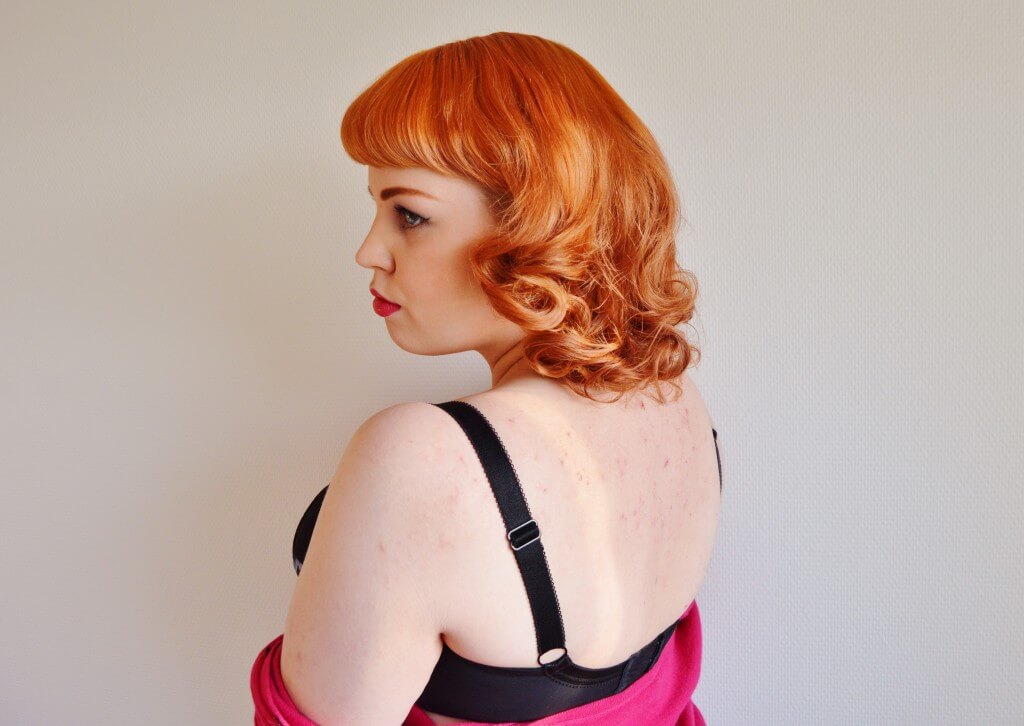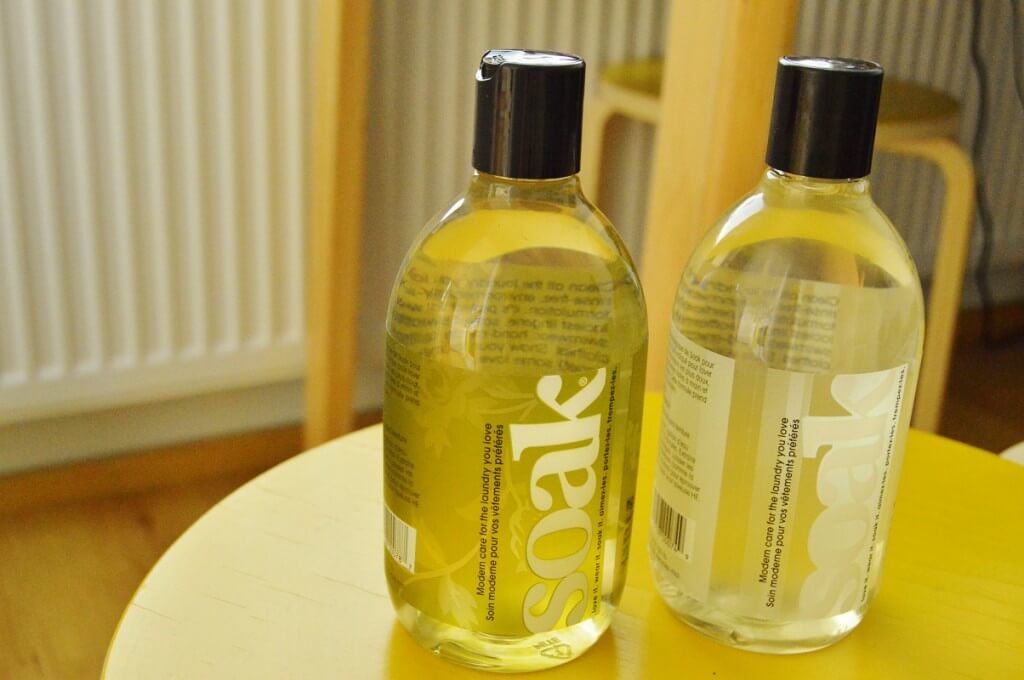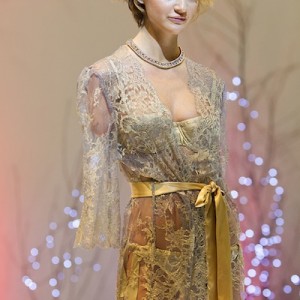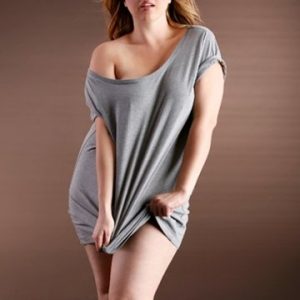When Frills Make You Cringe: How to Buy and Wear Bras with a Skin Condition
Today's guest post is by Mette Sofia Hänninen aka Miss Sophie Cake writes a full-bust focused lingerie blog called Two Cakes on a Plate. In addition to lush lingerie, she holds a passion for psychology (her major in Uni), pinup fashion, makeup, and other artistry. Mette aspires to be an art therapist one day, because creativity is everything.
Being a lingerie blogger means all sorts of things in practice and one of its perks is obviously getting to try loads of underthings. When a new delivery arrives at my door I am always super excited and usually rip off the packaging right there, no matter the situation (one time it was in the middle of the night and I tried not to wake my boyfriend --- easier said than done!).
However, trying on and actually wearing tons of different pieces to test them is not always the easiest and most comfortable thing to do --- at least when you are living with a chronic illness.
A Little About Me...
Ever since I was a child I have suffered from atopic eczema, which is an auto-immune disease that makes my skin extremely vulnerable to basically anything it gets in touch with. In practice, that means air, pollution, water, makeup, and any sort of bacteria.
My skin cannot defend itself from anything as the stratum corneum (the upper layer) is damaged. Skin conditions are usually dismissed as nothing serious. For example, they are completely ignored in most working environments. Bleeding and sometimes even not being able to turn your head are not seen as serious symptoms that affect one's working ability.
I'm not trying to collect a pity party as I have an extremely happy life despite my illness, but I am trying explain to you my background with this issue.
To get a glimpse of what my everyday life is like, I need to ask you to do some imaginary play with me. Imagine being in the middle of a forest and suddenly, as you are picking berries (that's what us Finns do!) or having a campfire, you notice a few mosquitoes have stung your arm. It starts to itch and perhaps, one of your friends tells you to stop scratching.
Then, imagine that happening to your whole body 24/7, and, just when that one mosquito bite starts to feel better, another one stings you in a different spot. At the end, you are left with countless itchy spots and, even at night, you have to sleep with two thick cotton socks on your hands to prevent you from scratching all your skin off while sleeping. That, my friends, is my life. I am an adult who wears mittens at night.
The Importance of Comfort When It Comes to Lingerie
To bring us back to lingerie, you might wonder what all this has got to do with my blogging and trying on piles of lace. Any guesses? Well, to start with the very obvious, lingerie is something that is worn extremely close to your skin. It is meant to make you feel good, look good and keep you comfortable.
When I review a piece of lingerie I focus on three key features: the look of the garment, how it fits on my body and, most importantly, how comfortable it is on my skin. I have been called out a few times for making comfort issues my top priority and praising a certain bra even when the fit is a bit off. But knowing my background, who could really blame me? The most important thing to me that makes a lingerie set a favourite is how it feels --- mentally and physically.
I don't go into much detail about my illness and how it affects the way I feel about lingerie on my blog, but as I know there are so many people suffering from this issue, I thought that maybe I could use this opportunity to give you some pointers about taking your skin into consideration when buying and wearing lingerie. Here are a few things you might want check before buying a piece for your everyday lingerie wardrobe!
Materials
This may seem a bit obvious but choosing the right materials is crucial to your comfort when your skin reacts to anything and everything. What is funny and frustrating about eczema is that you never know what makes your skin unhappy and how to treat it right. However, there are some things I know for sure make everything a little more easier.
My absolute favourite material to wear directly against my breasts is cotton. To my great joy, lingerie brands are starting to acknowledge comfort issues more and more, and Polish companies such as Ewa Michalak and Samanta line their padded bras with cotton to prevent skin from itching. Ewa Michalak and Katherine Hamilton Intimates (former Bosom Galore) are the queens of comfort when it comes to bra lining --- their bras are usually lined with plain white cotton so no harsh colorants are used to make the bra more "appealing" on the inside.
Another material that gets an A+ from me is silk. Even after blogging about lingerie for three years, I had not discovered the joys of genuine silk until I started to work for a local lingerie boutique. During my training period, I broke out in a horrible rash (the training was held in Helsinki, capital of Finland, which means a lot of pollution and street dust), and the lady who trained me gave me a silk undershirt to try as she had a daughter with a similar condition. Like a miracle, it calmed my skin and made me feel so much cooler than any other fabric I had ever put on. What a relief!
As a rule of thumb, I would advise anyone with eczema to go for natural fibres such as cotton, silk, and linen for everyday wear (and sleepwear!) and try to avoid super starched, rigid materials that don't feel soft to touch in the first place.
Seams, Lace & Trimmings
Some people with eczema are more sensitive than others. To illustrate, for me, bra seams are not a huge deal. However, seams can definitely irritate the nipple area for others (this is why some people with sensitivities opt for moulded cups). My mum, for example, likes a thin spacer foam cup as it breathes but does not have the irritating seams of an unlined bra. The seams can be done in such a way, however, that there is little to no irritation in the nipple area at all. Here, placement plays a big role!
What I however find more irritating than seams are some trimmings that are used to decorate the bra band edge. Some brands use rigid materials to make the band extra sturdy, but, for someone with sensitive skin, this puts more pressure on the damaged upper layer of the skin and chafing is inevitable.
Always examine the lingerie before buying any harsh or rigid materials that might itch. Something as simple as a low-quality lace that has no stretch and is placed near the armpit area could aggravate your skin. Know your own body and its most sensitive spots so you can make an educated decision.
Centre Gore, Wiring & Other Metal Parts
The same rules about trimmings and rigid materials apply to the hardware of the bra. Don't put too much pressure on a too small area of your body! I have found that flexible underwires are my best friend and prevent painful chafing when I have to wear a bra for several hours.
To test for flexible underwires, try to bend them a tiny a bit while examining the bra before buying (that is, if you shop in a boutique). If the wires are very rigid, there will not be much give and you can feel how the wire holds its shape even if you try to bend it. Another way to test the flexibility is to sit down and move around a bit with the new bra on. If sitting in a slouching position makes the bra wires stab you in your ribs, that could be a sign of rigid underwires.
In addition, the length and width of the underwires can cause irritation. This is why examining your breast root width is important for your comfort as well! The breast root, to put it simply, is the point on the body, underneath your breast, where the actual breast tissue begins and ends.
You can examine this by lifting your breasts (if necessary) and giving your breasts a little feel on the bottom half of them. This will tell you whether your breasts cover a wide or a narrow area on your torso. Too long wires (extending past your breast tissue and into the armpit) tend to poke one's skin and make the bra cup edge rub your skin near the armpit area. This can actually prevent you from moving your arms for fear of irritation.
What I find most crucial is the centre gore though. A gore that tacks too hard to my sternum or has an irritating material covering the wiring has several times left me with a semi-permanent, itchy rash between my breasts. And it doesn't stop itching when I take my bra off. Ouch.
If you have a similar problem, I suggest trying lower gores as they rarely tack as hard. Low gores can be found on either demi cup or plunge bras, with the latter usually being lowest. Fit-wise, plunge bras are not the best for everybody but again, consider what is your personal main priority when it comes to bras --- fit or comfort?
How to Wash and Take Care of Your Bras When You Have Eczema
When you have found your perfect everyday basics that feel good on your body, it is vital to treat those garments appropriately so they won't cause you any unnecessary irritation. The first thing is to use a sensitive skin detergent or just any regular scentless household soap (like Marseille soap) to wash your undergarments.
I personally use Soak which is easy and has proved to be pretty good for my skin. Soak is available in a scentless version as well which is great if you are allergic to strong scents. Remember to rinse your lingerie well so there is no detergent left in the fibres.
What is not known so well though is that dirt actually makes eczema a lot worse. This is why you should wash your lingerie after a couple of wears, even though it might feel silly. However, bacteria is a sneaky thing and it creeps into your clothing faster than you think. Keeping clean is the best and easiest way to make your skin happy!
Also, be sure to wash your underwear before you wear it for the first time. I used to work for a huge clothing chain and as I handled the clothes, my hands were full of red itchy spots from all the chemicals (not saying all manufacturers are the same but it's better to be careful). Definitely something you don't want on your boobs!
Parting Thoughts...
I am really hoping these simple tricks help you to figure out how to cope with your skin conditions and, if you don't have one, to understand what life is from the perspective of a person with a chronic skin disease. Maybe you know someone who scratches herself all the time or someone whose forearm looks like they own a cat. Show some love and share these tips with fellow itchy lingerie addicts! Also, if you have any tips or tricks of your own to stay comfy in your lingerie even with eczema or other skin conditions, feel free to comment below.






